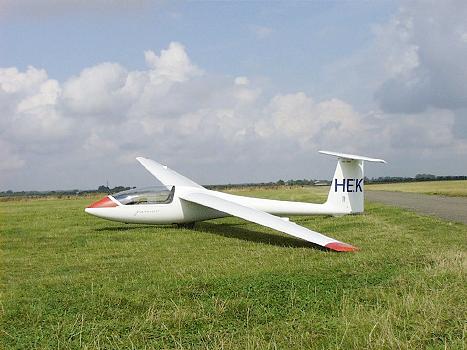
SZD-51-1 Junior, HEK. Cambridge has two Juniors, HEK and HDU.
This part of the story describes what happened after my first solo and how I converted to single seat gliders. It tells about learning to soar with confidence and of the path that led to my first cross country flight and completion of all the requirements for the Silver C badge. The Silver C is the initial internationally recognised qualification that a glider pilot can attain.
At the Cambridge Gliding Club a new solo pilot will have a check ride each day before flying solo in the glider which they first soloed. After four of these flights and some pre-conversion checks the student converts to the SZD-51-1 Junior. Hence, my first few solo flights were in the ASK-21.
17 Aug 00
I had a couple of short check flights yesterday in the ASK-21, HTV.
There was a strong breeze and turbulence but no thermals. The
instructor was happy and said she'd have let me go solo if the day
was calmer. I must be still making progress.
19-27 Aug 00 - Gransden Regionals
This was my first Regional contest, so I camped at the field all
week, helped out and flew whenever possible.
Saturday: Today I did some flying while the pack was out on its task. It was a lovely day with sun and cumulus. I had a check flight with Stefan in HTV. I found a thermal at 800 feet that started out gentle and developed, eventually topping out at 4300. Then I flew some stalls and we did some more spin practise, flying full spins and incipient spins. I've now learnt how to spin the ASK-21. The trick is to use a low-energy entry by flying a stall so gentle that it only mushes, then apply full rudder and try to pick up the wing with aileron as it drops. The ASK-21 will roll past vertical as it enters the spin. Higher energy entries will only cause a spiral dive. After this I flew my second solo. This was a 39 minute flight involving three thermals, but never getting above 2400. As a result I have the first leg of my Bronze certificate. This is a British national qualification and is as close as British gliding gets to a glider pilots license. To gain a Bronze a pilot must fly 50 solo flights which must include at least two soaring flights, which must exceed 20 minutes from a cable launch or an hour from an aero tow. Then there are four simulated short field landings and a written exam to pass.
Sunday: Another wonderful day. I set off in HTV with water and a barograph, but only found a hole and was down quite quickly under a big, dark, overconvecting thing that wiped the rest of the day.
Tuesday: Flew my 4th and 5th solos in HTV. Nothing exciting in the air, so they were just circuits.
Wednesday: Had two check flights with Stefan in the Puchacz as a preliminary to conversion to the Junior. Read the briefing notes and sat in the cockpit to get familiar with it.
Thursday: Today was a very hot, blue day for my initial flights in the Junior. The first flight was the first launch of the day in front of the grid while they were getting ready for the off. With no lift and a short cable I just got a circuit. I left the trim where I thought was right and had to close the brakes during round out, so did a rather untidy, long landing. The second flight was in early afternoon while the pack was away. I found a weak patch of lift over the airfield which I rode for a 12 minute flight. This time I trimmed for landing like the briefing said, which set up 55 kts right on the money, and got a much tidier approach and landing.
The Junior is different in most respects from any of our two seaters. For a start it takes off and lands on its main and tail wheels, so its attitude on the ground and the resulting 'picture' is different. Unlike the two-seaters it takes off in the same attitude it has when stationary and so you don't raise its nose and balance on the main wheel during acceleration. The belly hook is offset to the left, so it tends to swing right on take-off. A good landing puts both wheels on the ground simultaneously, so the 'picture' before taking off is what you need to see during a fully held off landing. Again, this is unlike our two-seaters, which land on the main wheel, dropping onto the nose wheel as they slow down. Its also more likely to swing on landing, so care needs to be taken to avoid ground loops. Its relatively noisy in the air and, as I was to find out, has quite a repertoire of hoots and howls. Its a much more responsive glider than the two seaters, thermals better, and the controls are very light. Its a real delight to fly.
 |
|
SZD-51-1 Junior, HEK. Cambridge has two Juniors, HEK and HDU. |
Sunday: Had a quick flight in the Junior in flat conditions before the grid was launched. The flight was little more than a circuit but I did land pretty much where I wanted to. Found some light lift but left it after a few circles because it was getting close to launch time for the grid. Took my tent down and left before lunch to go to John Williams' barbecue.
28 Aug 00
Bank Holiday Monday, the day after the Regionals. I made one short
flight in drizzle with the approach somewhat affected by crawling
drops on the canopy. This affects ones perception of which way the
target point is moving, making landing surprisingly difficult.
After the rain passed I had another flight under largely dead, very
calm conditions. I found a bit of zero sink at 800 feet over the
last sunlit field on the east side of Little Gransden near the
clubhouse end and stayed with it. It slowly developed to 2 kts up
and eventually faded away leaving me at 1000 feet. Then I found
another patch of zero sink at the other end of the field but it
soon faded so I came back and landed to find out I'd been up for 19
minutes.
25 Sep 00
Took Verena Greimel flying. She is an Austrian model flying friend
who was visiting to fly in the Stonehenge Cup, an open
international Free Flight contest. She had an aero tow in the
Puchacz, which she enjoyed tremendously. She took this photo of me
in the Junior:
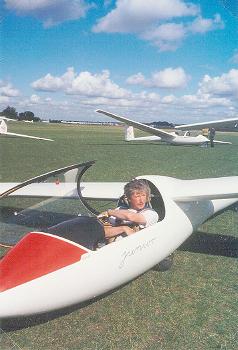 |
|
Myself in the Junior, HEK |
1 Oct 00
This Sunday started with a small breeze and a relatively low
inversion, 800 feet, and fog. As the fog burnt off cumulus started
to appear at around 1200 feet. By the time it was my turn to fly
HEK the Cumulus were still fairly flattened by the inversion and
had a base at around 2700 feet.
There was a nice breeze, so we were getting good launches. My first launch took me to 1500 feet and I found a rather light, scrappy patch of lift halfway down the field. I was down to 1200 at the time. Still, I centred it up, keeping a wary eye on the glide angle to the field, and it finally turned into 2 kts up once I'd passed 2000, finally petering out at 2400. A second nearby piece took me just into the cloud base at 2700. So, I left that cloud and practised a stall or two and an incipient spin. At this point I was about 2 miles downwind of the field so I headed for a nice, nearby cloud street, which I reached at 2500 and rode back to the field and onward about another 2 miles upwind without circling. I gained 100 feet during this, flying fairly fast for the Junior at 45-50 kts without really seeing any down. I ended this with a last climb to 2700. By now the sky was clearing and the street was breaking up, so I went home and landed 58 minutes and 12 miles after I launched. That was my longest solo flight as well as my first real thermal flight in the Junior. Quite unexpected as I didn't think conditions were that good.
Ken and Joy, long time friends I met through Free Flight modelling, came out to see the fun in the afternoon. They arrived just as I landed, so we signed her up for a flight and went over to the flight line so they could look at the gliders.
I had two more flights later after solid cloud cover had developed. Both got to a good launch height in the stiffening breeze, though there was no lift any more. The second one hit 1700 at the top of the cable and stayed up 9 minutes; I sat off to the side of the field and watched the Puchacz launch up and past me for Joy's ride, as I was down to 1100 by this time. Wonder if she saw me lurking? I was trimmed back to 40 kts at the time and was virtually stationery flying into the wind. The wind made for an interesting circuit and landing with lots of crabbing on approach and enough wind at ground level to sit with the wings level after I landed.
8 Oct 00
Another good day, the second good Sunday in a row. The breeze was
slightly east of north, so we set up on 35, the short runway. I was
second up in the Junior with calm conditions and a blue sky. My
first launch didn't contact anything, so I went again. This time
there was a small Cumulus 45 degrees right of launch direction and
at not more than 1500, so I went over and sat under it in about 1
up, having arrived there at about 800. It faded out after a time,
leaving me at 1200. Neighbouring lift was no stronger and, finding
myself back at 800 after having drifted back to the landing area, I
came down after 26 minutes of pleasant though careful flying. Both
these landings were made on full brake after cramped circuits and
were rather firmer than I liked; I was told afterwards that the
Junior will not round out properly on full brakes.
I had another flight in mid afternoon to cement the landing lesson. By this time there was an excellent cloud street down the west side of the field and the breeze had swung to about 300. Both the Puchacz and the ASK-21 were well up under the street, marking lift. After launch I headed directly over to the street and was soon in lift. After a first thermal climb I headed west out to the sunny edge of the street. A second thermal climb saw me at 3200, so I flew two or three stalls followed by four spins, two in each direction. The Junior is pleasant to spin, with a tendency to tuck under during recovery. Discovering that I still had 3000 feet after this, I climbed back up to the cloud base and headed south west for Hatley Park. Here I turned east and flew over to Wimpole Hall, where I picked up another thermal over the folly which took me up to the cloud base, which I reached over the middle of the grounds. From there I flew straight north along the east side of the B1198 to the south west edge of Camborne, flying at around 55 kts. From here I flew back to the north-east side of Little Gransden and came down to circuit height in a shallow spiral at about 65 kts, having decided that others might want HEK. Having noticed from smoke near Longstowe Hall that the breeze had swung still further west, I landed on 27. This time the approach was more open and as a result less brake was needed. A better round-out and landing resulted from this after 48 minutes in the air, having covered about 15 miles. This turned out to be the last day of the 2001 thermal soaring season.
27 Dec 00
I spent the Christmas and New Year break with my sister Jane and
her family in the Cotswolds. On this Wednesday I took the
opportunity to fly with the Bristol & Gloucestershire Gliding
Club club at Nympsfield, which is near Stroud on the eastern
escarpment of the Severn valley. This provided lots of new
experiences, which included my first real flights in an ASK-13, an
older generation wood and fabric glider, and my first attempts to
fly in ridge lift.
Nympsfield is at the top of a north-facing section of the escarpment that forms the eastern side of the Severn Valley and is just a mile or two south of Stroud in Gloucestershire. Its a beautiful situation and from the air above the field you get a wonderful view across the Severn valley to the Welsh mountains. The field is barely 50 m from the edge of the escarpment and its single strip is parallel to the slope and not exactly flat. The eastern end is flat and the highest part. From here a shallow saddle swoops down 50 feet or so before rising to a low hogback, with another saddle that ends at the western end. The whole field is convex side to side and surrounded by trees apart from the east end. Its almost a mile long. There was a north-east breeze, so landings and launches were cross wind. The landing circuit starts out in front of the slope and the base leg is downwind. This is the opposite of flat land conventions, but keeps you out of the curl-over behind the slope. In fact the curl over was pretty much non-existent because there was barely enough breeze to maintain height on the ridge. I had a 20 minute flight in which we went up 100 feet in the first 10 minutes and came down slowly for the last 10. The circuit was half the height I am used to because the entire pattern, apart from finals, was being flown in steady lift. I also learned a lot about contour chasing at 3 feet or so altitude after round out while waiting for the glider to stop flying. That's actually easier than I guessed. After my first bash at the ASK-13 another member asked if I'd like to visit Aston Down, a flat field about 15 miles east of Nympsfield, so we got into his Falke motor-glider with myself in the left seat. The Falke has a 1500 VW engine, side by side seating, a single wheel and you fly it like a glider, landing using airbrakes rather than the throttle for descent rate control. Fun, but it has a huge attitude change from a fairly minimal speed change.
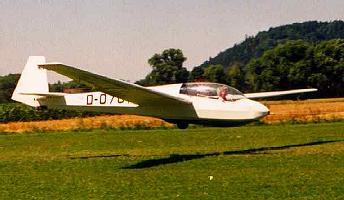 |
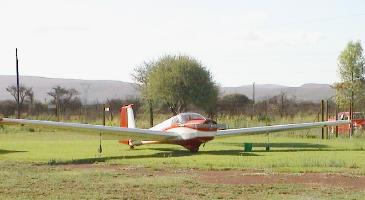 |
|
ASK-13 |
Falke SF-25 |
This Falke turned out to have a hook on the gear, so for the flight back to Nympsfield we turned the 3-blade prop so the top blade was vertical, set the prop brake, got hooked on the cable and were winched off to 1300 feet in near silence. We then glided around a bit to prove that Falkes glide well, before starting the engine at 900 feet. I flew back to Nympsfield. We got on the ridge and were riding along it when the carburetor iced up and the engine stopped. No problem said Malcolm, who glided on a bit before joining the circuit and dead-sticking in. Once we'd stopped rolling he restarted the engine to taxi over to the hangar. All in all I had a lot of fun, met some nice people, and learnt a lot.
30 Dec 00
Saturday saw me back at Nympsfield on my way back to Harlow. It had
snowed all day on Thursday, so we had an unbroken 75 mm thick
covering of snow on the airfield. The start of flying was delayed
while we thawed out the block of ice that had accumulated in the
ASK-13's wheel box during the previous day and was now stopping the
wheel from turning. This time the wind was from the north-west and
swung to due west during the day; there was only a very light
breeze with the result that the ASK-13 wouldn't stay up. I had
three ASK-13 flights, of which the first was a simulated cable
break which the instructor pulled "to see what I would do". I flew
an abbreviated circuit and landed without mishap, though I was very
slow after the simulated break because the ASK-13 accelerates much
slower than anything else I've flown. This day had a clear blue sky
and the view over the Severn valley to the snow-covered Welsh
mountains was fabulous. The last landing was interesting. We were
following an all white Nimbus round the circuit and on the base leg
the instructor asked where I was planning to land. When I said "To
the left of the Nimbus" he replied "Good plan". The Nimbus landed
as we were turning onto finals and completely vanished as soon as
it stopped rolling. I said "I've lost the Nimbus" and a comforting
"So have I" came from the back seat, but when we too stopped we
were well clear of it. That was a real object lesson in being wary
of unusual conditions and in not landing directly behind another
glider.
31 Dec 00
I went flying at Cambridge. Gransden Lodge was also snow covered.
We had a southerly breeze that started out light and increased
until it was quite strong. Unlike Saturday at Nympsfield, which was
sunny, there was a high overcast and the wind was raw when we were
outside. We had our bus at the launch point for cover and both that
and the cockpit were warm. There weren't many of us there and so we
just flew the ASK-21. By the time it was my turn to fly we had 25
kts at ground level. Launches got off the ground quite fast and
really whistled up with the winch virtually stationary. I'd always
wondered what sort of conditions could cause the ASK-21 to climb
out at 80 kts and now I know! We were flying from 17, our shortest
runway, but were still getting to 2000 feet before releasing the
cable. Once up there we found a 45 kt wind, the same as the
ASK-21's best glide speed. I measured it by trimming to 45 kts and
hovering above the winch, before getting bored, trimming up to 50
kts and practising for ridge flying by crabbing along a cross-wind
peri-track, to the considerable amusement of Rod Ward, was in the
back seat. Circuits were interesting. The ground speed was over 100
kts on the downwind leg, followed by a heavily crabbed base leg and
a very steep 60 kt final approach on full brakes. The wheel brake
was totally useless on the snow.
14 Jan 01
There was a good high sitting over the North Sea for the last five
days. It was still there today and I had a great time flying as a
result. The day was cold, not much above freezing, but cloudless
and blue. Not a drop of lift. There wasn't a lot of wind on the
ground but there was a steady gradient to around 35 - 40 kts at
altitude. The wind was easterly so we were flying from the far end
of the main runway. I flew the Junior and got two flights in. As a
consequence of the breeze I got to 2000 ft on both launches and had
nice 10 minute flights, though I did have to keep a wary eye on the
drift. It was really lovely up top. I could see buildings in
Cambridge, 10 miles to the east, and the coloured sails of boats on
Grafham Water, 12.5 miles north east, but Bedford, nearly 15 miles
west, was just a brown area. I finished by doing the hangar flight
for the Junior. I did a nice long approach for over the crop
alongside the main runway and landed on the near edge of the
'diamond'. Once down, I pulled the brakes in and let HDU run out
toward the hangar area. It stopped within easy pushing distance of
the hangar.
14 Apr 01
An absolutely brilliant day. I arrived in time to do HDU's daily
inspection and tow out and consequently got the second launch of
the day. The launch was into a thermal, which I rode up to 1700 and
then abandoned because it was straight down the runway. A long
upwind leg and scratch under a likely cloud turned up nothing, so I
went home and landed after 10 minutes.
My next launch, just after 13:00 and in HDU once more, again put me in light lift, which I rode up to 2000. Then I headed upwind, picking up much a much more powerful patch at 1400 feet. I rode this to 4500, abandoning just in the mist at the bottom of the capping cumulus. I headed back toward the field across a blue patch and snagged the next thermal at about 3000, this took me back out across Great Gransden and Ettisley and back to 4000. From here I flew across to the roundabout and Chinese restaurant on the junction of the B418 and B1198, arriving at about 2500 and thermalled back to 3000 just north of the junction. Then I flew south down the B1198 to the roundabout just south of Arrington, taking in three thermals along the way. The last of these was quite narrow, and I found myself coring it in a 70 degree bank with the stick well back and still going up at 4 kts. I turned north again and climbed back to 4000 above Wimpole Hall in preparation to flying back north along the B1198. I had a final thermal just over the go-kart track north of Longborough before coming back to the field. Finding no thermals on the north side of the field and being down to 1000, I joined the circuit and landed after 1 hour 49 minutes, having covered just over 20 miles by the map. This was my first solo flight of over an hour.
Here's a satellite map of the weather at 14:30. There are beautiful cumulus all over our area and hopeless conditions west of a line from Brighton to Liverpool:
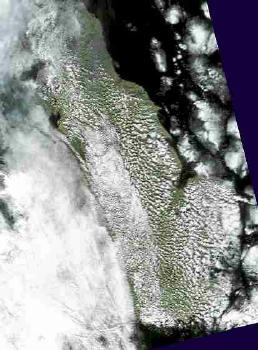 |
|
Apr 14, 2001 at 14:30 |
I finished the day with the hangar flight in HEK, playing with some very light, smooth lift all down the side of the field and gaining 200 ft in the process before joining the circuit and putting down with a rather bounced landing near the hangar after 20 minutes.
29 Apr 01
I'd been out yesterday, Saturday afternoon, which was very windy
though thermic. However I didn't get a flight because the ASK-21,
which I wanted, stayed up for 1 3/4 hours and it was too windy for
safe ground handling of the Juniors. This Sunday morning was still
quite windy and the Juniors were in the hangar, so I took an aero
tow lesson in the Puchacz. I flew the tow from 500 ft to 2400 ft
without problems, pulled off and we went thermal hunting. We
thermalled up to 3000 ft in a lovely clear weather. Visibility from
there was at least 25 miles except to the east where a thick
rainstorm about 4 miles away remained stationery for the next hour,
but I digress. At this point Steve Gibson, who was instructing,
asked if I'd spun recently and sounded disappointed when I said I
had, though that didn't stop him handing me an incipient spin to
sort out a bit later. Again I digress. There was a brief pause
before he asked if I'd looped recently. When I said no, he sounded
happy and promptly demonstrated one before telling me to fly a
couple. Fun. After running the HASELL check: Height, Airframe
security, Straps, Engine(not fitted), Location, Lookout all round
and below, we started. Trim and stick both well forward and dive
steeply to 95 kts then pull up at 2G, keeping the stick coming back
across the top and easing it forward as we come down the other side
before pulling out and zooming to convert speed back into
height.
Then we thermalled back to cloud base and set off up a cloud street for 7-8 miles so I could learn to dolphin. This is the basic cross country travel technique. You stay under the line of clouds because blue patches are not the glider pilots friend. You adjust your speed depending on the variometer reading, slowing down in lift and speeding up in sink. There's a movable scale, the MacCready ring, that fits round the variometer. Its calibrated to suit the type of glider and shows the correct speed to fly. The calibrations are in kts. You set zero to match your expected thermal climb speed for the day. This has the effect of increasing the indicated speed to fly as you dial in stronger thermals. In the Puchacz your dolphining speed varies from 42 kts, it's best thermalling speed, to around 70 kts in strong sink. The Junior's speed range is similar and, if you're lucky enough to be flying a Discus the speed range would be something like 45-90+ kts.
After a while we came back, I flew a couple more loops and followed this by an abominable approach. We landed after 1.5 hours. I went up in the Puchacz again, this time on the cable, in the late afternoon in a partially successful attempt to sort myself out. I did a bit of thinking during the week and now know where and why things went wrong, so I should get it right this weekend. Anyway, I got 2 hours soaring in two flights and counted it a decent day.
The Puchacz has a large rudder and relatively high pedal forces, but even so I was a little surprised to find that my legs had noticed those flights. I guess I'm finally using enough rudder in the beast!
5 May 01
Bank holiday Saturday and another wonderful day. Only one flight in
the Junior, but I stayed up 2 hours 52 mins and only came down
because I was getting thirsty. I started by getting to 1700 ft on
the launch because there was a good breeze and because I launched
into lift under one end of a cloud street, which is always nice. My
upper and lower limits were 900 ft and 3800 ft, which was just in
the cloud base, and I haven't yet looked at a map to see where my
wanderings took me, though I got most of the way across to the M11
near Cambridge and scraped back when the street that took me there
decayed, hence getting back to the field at 900 ft an hour into the
flight. Later I went round the windward end of Papworth Everard. At
the end I had a calf cramp while I was letting down to join the
circuit. I was pleased to see that it was just discomfort and
didn't really interfere with flying. I practised slipping after it
wore off because it seemed a shame to just dump the height on the
brakes. So.. good practise at dolphining up cloud streets, practise
at staying up, to say nothing of a spin or two, just for fun, and
the start of slipping as a new skill. A good flight.
I had been after a two hour target for my Cross Country Endorsement to the Bronze Badge and certainly managed that. The Cross Country Endorsement is a prerequisite for starting cross country flying and requires soaring flights of one and two hours, which can also be counted toward the 50 flight Bronze requirement. After getting the Bronze badge, the Cross Country Endorsement is completed with a VFR navigation exercise, field selection and field landing practise. At Cambridge we do the last three requirements during two motor glider flights.
7 May 01
Bank Holiday Monday was excellent too, despite the intervening
windy, overcast Sunday. I finished off the 50 flights for the
Bronze log book requirement with three flights that totalled over
three hours, making over 6 hours air time for the weekend off four
launches.
The last flight was great: there was wonderful streeting with almost continuous lift under it. On the last part of the flight I left Arrington roundabout, 5 miles south of the field, at 3000 and cruised back up the street at best glide speed, 41-46 kts, without circling to arrive alongside the field at 3800. Then I continued five miles further north to the Chinese restaurant to complete my third pass along this section of the B1198. North of the field I was having to dive under some clouds at 70 kts because I was up to 4000 and some cloud bases were only 3800. I got to practise slipping on my way down to circuit height. Slipping is coming along. Not good enough to yet to attempt a slipped approach, but getting there. Must try slipping with full brakes some time; the height loss should be spectacular! This was my 50th solo and my 150th glider flight, counting the Front Royale flight as no. 1.
13 May 01
Took and passed Bronze flying tests in HTV with Peter Baker
instructing. On the last flight of the series Peter pulled a nice
instructor trick. I was flying the downwind leg in the circuit when
he took control, turned in and started to speed up. I was still
trying to work out what he was planning when he straightened out
into wind over the middle of the runway, pulled the nose up at 45
degrees and yelled "Bang! Cable break! You have control". It was
nicely done. After I'd pushed over and got enough airspeed there
was too much height to land ahead and too little to try a circuit.
There was only one way out, so I flew a fairly tight 360 degree
circle to loose height and then landed straight up the runway.
3 Jun 01
This was a day that I originally had no hope for, it was so windy
first thing. However, by the time I got to the field in late
morning it had turned into a surprisingly good day. By the time I
got into a Junior the cloudbase was 5200 feet, with sufficiently
strong thermals to stop the fresh NNE wind from being a problem. I
launched in HDU at 13:18 from the short run, getting to 1200, but
immediately hitting heavy sink down to 900 feet. At this point I
joined the pattern, only to hit +2 kts at 800 feet near Longstowe
Hall. I rode that to 2000, getting blown south east over the B1198
in the process. Then there was a series of short climbs punctuated
by moves up wind until I eventually ended up at about 3000 under a
good cloud street on the windward side of the airfield. It this
point I hit a decent thermal that took me straight up to 5100 and
just into cloud base. I followed the street to windward, getting
two more short climbs and eventually making 5200. At this time I
headed out east of The Gransdens and dumped all the height with a
series of three spins and some side slips, landing after 76
minutes. As I'd carried my barograph, this flight was documented as
a Silver height leg with a gain of 1320 m. Adequate margin; 1000 m
was required.
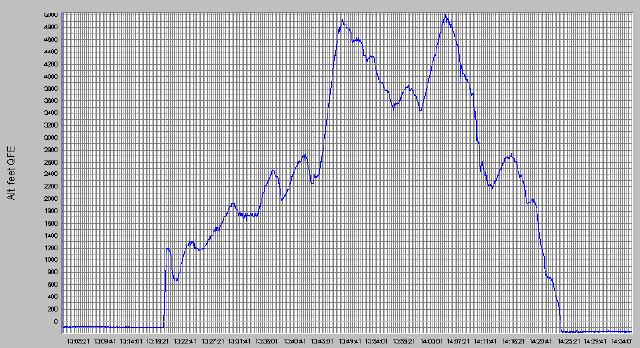 |
|
The EW model D logger trace of my Silver Height flight. |
About 16:40 we decided to fly the Juniors back home. I took HEK for my second flight of the day and Adrian flew HDU. My launch was almost a repeat of the earlier one, pinging off at 1200 and hitting heavy sink as I headed for the kart track, or rather for a nice cumulus above it. Heavy sink meant -6 kts and running the speed up to 65 kts to try and escape it. Once again I hit lift at 800 ft and zoom climbed into it, but this time it was strong, turbulent stuff that took me straight up to 5100 ft, with +5.8 kts on the averager for over half the climb. Once up there and under a nice cloud street, I flew north to the B418, passing east of the Camborne water tower and then turned west along the northern side of the road. Shortly before arriving at the Chinese Restaurant roundabout I spotted the EARS rocketry group at their launch site and parked in a thermal to the west of Papworth Everard in order to get a good look at them while I cranked up to the cloud base at just over 5200. Then I went west to the outskirts of St Neots before turning south east and heading down to Top Farm, a tiny power strip, via Abbotsley and on to the water feature in the Wimpole Hall vista to the south of the Arrington roundabout. From here I had a splendid view of Bassingbourne, where we used to fly Free Flight models in the mid 1970s. While I was parked in a thermal over the water feature a twin engined jetliner, a small Airbus or possibly a 757, flew across near Royston at about my height and less than 5 miles away. Bet he didn't see me! From here I cruised up the east side of the B1198, leaving Wimpole Hall to the west and crossing Bourn airfield above 4000ft. After another flyby of the EARS site I turned for home, trimmed up to 55 kts and cruising, and flew anticlockwise on a large circuit of Gransden Lodge (GRL) before joining the circuit east of the clubhouse, flying down to the far end of the short run, and making a long approach over crops to the diamond in front of the hangar with a jink right to take my approach well clear of a tractor working in the field. I stopped rolling 100 m or so from the hangar. I'd flown about 33 miles in 96 minutes. Adrian landed just after me with his Silver height also well in hand.
9 Jun 01
Debbie observed and signed my log for two Bronze spot landings. The
third not done as it should be on another day.
23 Jun 01
Its a club tradition that we celebrate Midsummer day on the nearest
Saturday or Sunday; this year Saturday was the day. This meant that
I skipped the usual Friday night session at Sid's in favour of
sleep, because I was up at 02:00 and on the road in time to help
unpack the hangar at 03:00 just as it was starting to get light. I
nearly ran over a fine, full-brushed fox as I drove onto the
airfield and then passed a hare and a rabbit. As the gloom
lightened we did the DIs on the gliders and then got them and the
winch in position. Official dawn was 04:09 and we got Bluebell, our
51 year old Slingsby T.21b, away at 04:15. I got my first flight of
the year in Bluebell at 05:00. It was lovely and quiet up there. I
flew the whole flight after launch and did my first landing in her.
Its quite different sitting side by side in an open cockpit at a
screaming 30 kts with just a tiny aero-screen for protection. We
didn't start flying modern stuff before 05:45 because the dew was
misting canopies too badly for launches to be safe, but I did take
HDU, one of our Juniors, up the cable for its first flight at
06:00. I had three flights in total before we stopped for
breakfast. Afterward we decided that we had a tail wind and swapped
ends on the run, so I flew the Junior to the far end. When I
launched for this flight at 09:30 the lift was starting and I got a
nice, one hour flight in and then got an hour and a half flight at
12:30, finishing the day with a short hangar flight at 18:00. It
was a difficult day, with massive sink, up to 800 fpm down, and
never more than 300 fpm thermals. To cap it all the conditions were
nearly 'blue', with decent cumulus only forming as the thermal
died, so there was nothing or sink under the clouds and lift was
elsewhere and marked only by light, wispy stuff. Come 19:00 the
order of the day was pack the hangar and back to Sid's for a quick
couple of beers before heading for home and a curry.
24 Jun 01
So.. a late start was called for on Sunday. I got to the field
about 12:30 just as the cumulus was starting to mark decent lift. I
wandered over to get my name on the flight list to find both
Juniors parked up and nobody wanting them. I grabbed the best, HEK,
and put it on line. First launch was basically into sink.
Frustrating as I was quite close to Bluebell, which was in a nice
patch at 2000 or so, but she was over the Little Gransden ATZ while
I was only at 1200. So, back home in heavy sink for a re-launch.
This time I connected and had a nice flight for 1 3/4 hours and
covering around 33 nautical miles. I flew round the east side of
Wimpole Hall and just past the southern side of Kneesworth, getting
a good look at Bassingbourne from all sides before heading over
nearly to St. Neots and then east to Papworth St. Everard. It was
an easier day than Saturday because the thermals were generally
under the clouds and a bit stronger, but the sink was just as
strong. Above Papworth I was at around 2500 and low man in a
thermal, with a dayglo green hang glider 500 feet higher and one of
our guys 500 feet higher still. I couldn't catch the hang glider
because I was sufficiently late in to the thermal that I dropped
out the bottom as it decayed, but I was at least outclimbing him
before that. About this point a severe case of numb bum set in so I
went home, rounding the east side of Bourn airfield, and
landed.
Just before 18:00 I squeezed in an aero tow lesson in the Grob in preparation for my trip to the USA in October. Winch launching is almost unknown there, so getting an aero tow sign-off was high priority. This lesson was aided and abetted by the Walkers, with Richard instructing and Anne tugging in the Pawnee. I thought the flight was not too bad for a first attempt in that glider and I was better pleased with my speed control on the landing approach than the last time I flew it.
1 Jul 01
Today, Sunday, was supposed to be blue and hot. Well, it was hot
and humid all right. It was 28-30°C and around 70% humidity,
but turned out to be solid overcast all day.
I drove up to the field early to grab a Junior and finish off my Bronze, so I was quite happy at the blue prediction because I didn't need to soar. It dawned clear but the overcast was solid by the time I left Harlow at about 08:15 and stayed all day with just a gentle breeze. I had a 'settling down' circuit and then went for the final Bronze spot landing, but the task was new to me this time. The previous two were on the lines of "We've marked out a short field. You can't undershoot or you'll be in the crop and you must stop before the imaginary far end hedge". This time Richard Hardy sent me off, with the altimeter scrambled as usual, and then they parked the Strangerover at an unknown spot on the field and I had to stop in line with it, never mind where I touched down. I landed short of the ideal spot, saw I had a long way to go, pulled the brakes in and kept rolling, eventually coasting to a stop about 10 m short of the target line. That was judged good enough. I will have my Bronze once the CFI has signed the paperwork and I've sent it off to the BGA. That's a big load off my mind. Now all I must do before October is get that aero tow qualification.
I got a soaring flight later in the day, but it was hard. I launched with a red strop because the only blue one on the field was at the winch and it was too hot and sticky to sit in the glider and wait. In consequence I didn't pull on the way up because I didn't want to break the weak link. The result was a very fast, flat launch with a release at 900 ft due to over-speeding rather than a normal one at 1400 feet. I settled down and went scratching for lift, finding a narrow and weak thermal over a stubble field at 750ft that gave me all of 0.5 kts climb. I kept working at it until I got to 800, repositioned and got to 900, repositioned again and made 1200 feet, catching up a nearby Discus in the process, repositioned yet again and eventually found +2 kts and got to 1800 which was well above the Discus. After that the lift gave out and there was nothing much around, so I went home and landed, to find that I'd managed 42 minutes. The Discus did exactly the same time and I'm not sure that anybody had a longer flight all day. All in all a tough flight, what with not being really high enough for cooler air and the large amounts of concentration and care needed to go up at all. I was really pleased I'd slung the Camelbak in the plane before I went. The beers after we packed the hangar went down really well.
11 Aug 01
The weekend was a bit worse than usual. I went flying on Saturday
because the Sunday forecast was bad. In fact Sunday rained and blew
all day. Saturday turned out to be windy, turbulent and overcast,
so no lift. I had a quick proficiency ride in the Junior in mid
morning and then snagged our Grob after lunch for an aero tow
lesson because the instructor cabal had decreed that I need to fly
a tow in lumpy, bumpy conditions. This was done without mishap and
then, to my surprise considering the conditions and that I'd never
flown the Grob solo, the instructor got out and sent me off solo
for another tow, still in the Grob. That was fun despite a lack of
lift and another decent landing resulted. After landing I hunted up
the instructor, who asked me if I was dead yet. When I said I
wasn't he signed me off for solo operation in the Grob and for aero
towing.
The fun continued. There is a new glider on the field. Its a Slingsby Capstan, which is a wooden machine from the early 50s. It looks like a big Radio Control model and has a very flat, wide fuselage. Its a two seater with side by side seating under an enormous clamshell canopy. I got a ride in it and, after a quick briefing, I was detailed to fly the launch and most of the flight. I want to fly it in thermals! Its the easiest glider to fly that I know. Speed control and co-ordinated turns are both simple and the view can only be described as helicopter-like because the canopy extends down below knee level and it flies in a very nose-down attitude. One of its owners flew the landing which was, err, steep. The Capstan has speed limiting air brakes, which means you can go vertical and not speed up, and in the strong wind we needed to stay close to the field. The result was that we did the final turn barely 100 metres from the threshold of the runway but at 600 feet. At this point the brakes were opened and boy did we come down! At one point I got what seemed to be a vertical view into the crop about 10 m from the runway while still at 200 ft and I was looking straight ahead at the time. Quite remarkable. It didn't speed up during this and very shortly after that we rounded out and floated in to a good landing.
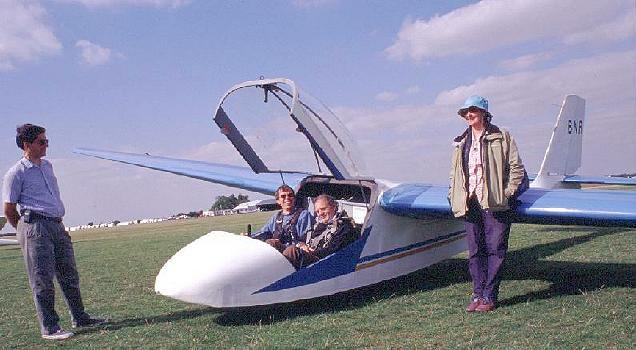 |
|
Slingsby Capstan |
18-26 Aug 01 The Gransden Regionals
I camped at Gransden Lodge and flew a lot.
Saturday: I was in the back seat of my mentor's Duo Discus for the first task of the event. We didn't get far, just 22 km, landing at Little Staughton airfield on the far side of St. Neots and eventually de-rigging the Duo and retrieving it by road. The Duo is a wonderful glider. Its whisper quiet at all speeds once the wheel is retracted and is very comfortable
Sunday: I had a session in our Falke motor glider with Kevin, our professional instructor. I flew a navigation exercise and field selection exercises for landing out. We were out an hour, dodging heavy rain showers. I got those sign-offs; the task for the day was scrubbed due to the weather and lack of thermals.
Monday: I did my first single-seat aero tow in a Junior. I put HDU on the back of the grid and helped with the rope running while the competing gliders were launched, then hopped in and was launched last in the pack at 13:45. I was happy with the launch apart from veering out to the left in cross wind after leaving the ground, but found the Junior was less skittish on tow than I'd expected. I hit lift fairly soon after release and, though it was quite a difficult day at times, the visibility was great. The sky developed as the top cover vanished in mid-afternoon. The pack started to return about 17:00, so I hung around at 3000 feet for a while before chasing around a few clouds and eventually finding a nice stable cumulus patch over nearby Bourn airfield, which kept me going until 19:00. By now the pack were all back: that is, those that were going to return. With the way clear I glided slowly and peacefully home, landing at 19:25, 5 hours 40 minutes after launch and with my Silver 5 hour duration flight safely under my belt.
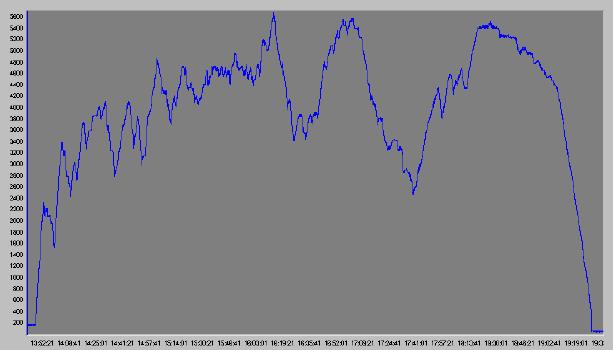 |
|
The EW model D logger trace of my Silver Duration flight. |
Tuesday: I was due to ride back seat with Team Grob this day. Its a club tradition that the club Grob 103a is flown in Club class at the Gransden Regionals. An experienced pilot does the flying, while Bronze pilots occupy the rear seat and help with lookout and navigation. Its a good learning experience. There was a last minute pilot change and I found myself flying with Mike Young. He's the best pilot in the club and flies 747s with BA for a living. Our task had three turning points: west to Buckingham, then north-east to Thrapston, east south east to Newmarket and then back west south west to Gransden. That's 216 Km in all. Mike's game plan was to take it easy, going for getting round and staying high rather than speed and it worked spectacularly. We got round in 3 hours 20 mins and were first in class for the task. We were on final glide from 3500 feet above Cambridge, about 10 miles to the east of GRL. As it became obvious we would easily get back Mike began to speed up, trading height for speed. A mile out we were doing 85-90 kts at about 200 feet. One field out we doing 110 kts at 4 feet: as we passed the remains of a hedge rather than going over it I looked past him and up at the edge of the airfield. We came over the runway threshold at 90 kts or so and 10 feet up. Mike hit the brakes, bled off the speed and we touched down and rolled to a stop 400 m up the field. Did I have fun? You bet! Did I learn lots? Yes! Just how much will become apparent in future. Mike explained his routing strategy very well. Its also apparent that he practises a lot. His skill in reading clouds and finding the sweet spot under one is outstanding: he tends to pull up under the cloud, ignoring preliminary lift patches and then circles in 'the one', somehow managing to turn the right way first time almost every time.
Wednesday: I was in the back of the Duo again on a very weak, tiptoe sort of day. We sort of crept out into East Anglia, eventually landing 80 Km or so down track and just 8 Km short of the first turn point at Diss after nearly two hours. We put down in a short, uphill stubble field after approaching over a tree line. This was an object lesson in how to do it. We went looking for the farmer, but found two nice ladies with a 7 month old wolfhound that leans on people. They were very pleasant, chatting in the garden over a red wine spritzer. The farmer, when contacted, was pleasant too, so de-rigging and the subsequent ride back was no problem.
Thursday was a scrub, with low cloud and drizzle.
Friday was a task day, so I was rope running when the grid was launched. It was also my day to crew for the Duo. It got round the task and came back so I didn't have to go get them, but didn't do much else either.
Saturday was a scrub with good weather out along the course, but there was too little lift locally to allow the field to stay up while they all launched. Starts are a bit like yacht races. We use lots of tugs and stream launch the grid of 60 gliders, 30 in each class. The gate opens, like the commodore's start gun, 10 mins after the last glider in a class is launched so the first in a class to launch may have been up for 40 minutes already. I went off with Kevin in the motor glider before task briefing and did field landing exercises. This involved selecting fields and then flying circuits and approaches into them. Kevin thought I did OK at this, so I got another sign-off. In the afternoon I amused myself with a second, better managed, aero tow and then a winch launch, but it was hot, sweaty flying for little gain. The thermals were weak in blue conditions.
Sunday was another scrub with low overcast and drizzle.
27 Aug 01 - Bank Holiday Monday
This was an excellent, though blue, day. Having booked HDU for the
day, I took a winch launch around 12:45 to see what was up there. I
found wonderful clear, cool post-frontal air with plenty of
thermals in the blue and surprisingly little sink. So, having
launched into lift I cut a notch in the barograph trace and,
eventually getting to 4000 feet and having determined that I could
stay up, set off towards Cambridge to see what transpired.
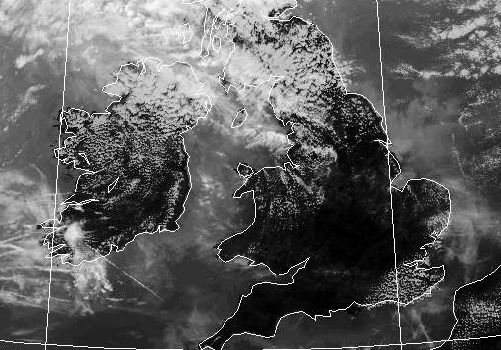 |
|
An infra-red satellite weather picture at 1327. This must have been taken just after I passed Cambridge. |
What transpired was good enough that I kept going past Cambridge, struggled through weak thermals and strong sink past Newmarket and then carried on to Bury St Edmonds, where tiny cumulus appeared and the lift got strong. I landed at the Rattlesden Club at 15:25 after almost 3.5 hours. I was greeted by the tow car with an enquiry about Silver distance and offered congratulations when I said it was. Paul Morrow drove my car over with HDU's trailer and we de-rigged the glider, trailed it back to GRL and I got home late. I'll return the favour when he goes for his silver distance. That was my first cross country attempt completed successfully. It also completed my Silver badge tasks.
 |
|
GPS trace of my Silver Distance flight |
20 Sep 01 - Silver C badge
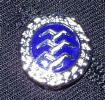 |